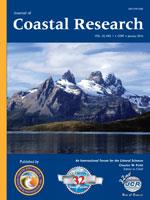Cheng, J.; Wang, P., and Smith, E.R., 2016. Hydrodynamic conditions associated with an onshore migrating and stable sandbar.
In this study, large-scale three-dimensional laboratory data were analyzed to identify the hydrodynamic conditions associated with the onshore migration of a sandbar and the subsequent equilibrium state of a stable bar. The initial sandbar was constructed offshore and out of equilibrium, with a symmetrical shape. The bar became asymmetrical as it migrated onshore. As the rate of onshore migration slowed, the bar was restored to a symmetrical shape toward an equilibrium state. Wave and near-bottom velocity across the surf zone were measured during the onshore sandbar migration. The near-bottom velocity skewness analyzed wave by wave indicates that before the sandbar reached equilibrium, the velocity was skewed offshore in the nearshore region and was skewed onshore seaward of the bar. However, the velocity skewness pattern reversed when the beach profile reached equilibrium and the sandbar became stable. The location of maximum undertow velocity moved from nearshore to the bar crest as the sandbar evolved toward equilibrium. Furthermore, the peak onshore-directed acceleration was greater than the peak offshore-directed acceleration throughout the surf zone during the periods of both onshore migrating and stable sandbar. The maximum difference between the onshore- and the offshore-directed acceleration occurred at the seaward side of the bar crest. The analyses of the hydrodynamic conditions associated with sandbar movement in a controlled laboratory experiment provide insights on the mechanisms of sandbar migration.





